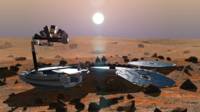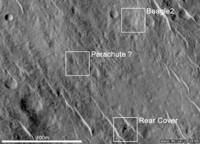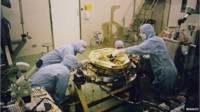- January 16, 2015
Post

presumed dead when landing on Mars probe British “Beagle 2″ is found on the whole surface of the Red Planet.
high-resolution images taken by NASA orbiter, fixed landing site probe December 25, 2003.
The picture shows dropped braking parachutes and cushioning air bags used in the soft landing of the probe, and the probe itself, which is in the normal position and has no signs of damage.
The probe “Beagle 2″ did not come out on the radio after landing, despite all attempts to ground and flight leaders then came to the conclusion that it crashed during landing.
However, the new orbital images contradict this theory and suggest what might have happened to the probe.

The lander to reach the surface, had to be developed in the form of three “petals”, which installed solar panels. The images show that the system has not been fully deployed, and that only took two batteries regular position. This may mean that the radio antenna is required for communication with Earth, also has not been deployed.
This data should be even more upset scientists and developers of the British probe, as they confirm how close they were to success.
Snapshots US orbiter suggest that the landing probe “Beagle 2″ is just 5 km from the center of the target area, which is an ellipse 500 km long and 100 km wide in the equatorial plain Izidis.
This means that the landing system worked very accurately, and until the last moment on board the probe was all right.
The probe was brought to Mars European apparatus “Mars Express”, which still continues to work on orbit around the planet.
The probe separated from the orbiter December 19, 2003, and the camera recorded his image before the active period of deceleration and descent. Then the connection with the probe was lost.
These images now show that the probe successfully reached the surface, and that at the very last stage, the system deployment has faced some obstacles – it’s possible that one of the cushioning air bags hit the deployment mechanism of solar panels.



Currently, the European Space Agency is preparing to launch the device “ExoMars”, which landed on the surface of the planet Mars rover with on-board laboratory in 2019.
In contrast to the probe “Beagle 2″, this the unit will liaise with the Earth at all stages of landing.
The system of planting this device developed by Russian specialists, but on-board equipment, including radar, used during the descent, created by European companies, and will be tested at the end of 2016.
Detection probe “Beagle 2″ followed less than a year after the death of the mastermind of this project the British astronomer Colin Pillinger. He did much to revive interest in space exploration in the UK.
No comments:
Post a Comment